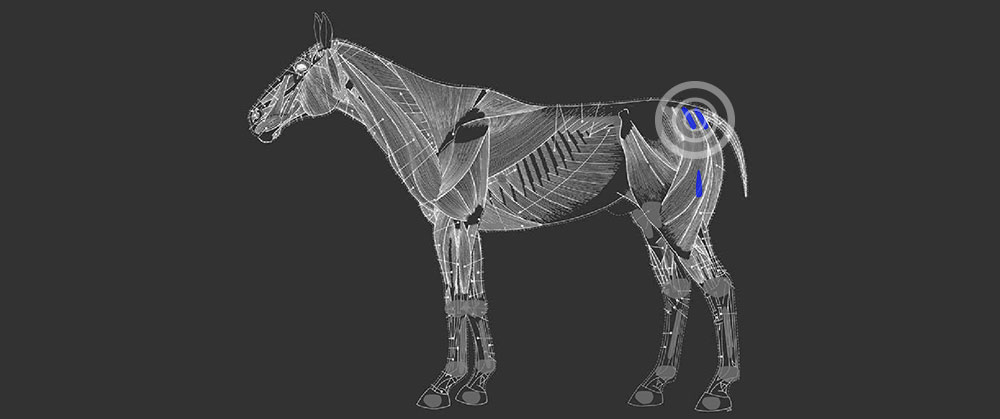Horse Hamstring Injuries
Hamstring Injuries


Of these three hamstring muscles the semimembranous is the most stressed muscle of this group. Tears and strains can develop in the muscle causing hypertonicity, however the muscle may be compensating secondarily for other painful areas in the body. The tendino-muscular origins of this muscle attach primarily to the tuber ischium with smaller origins at the coccygeal vertebrae and sacrotuberale ligament. The muscle inserts on the medial stifle and assists stifle and hip flexion as well as adduction of the hind limb. The origin of the muscle at the tuber ischium is the number one site of injury for this muscle, however injury can occur in the belly and insertions of this muscle.
Strains and tears cause a local bunching of muscle tissue and inflammation in the acute stages with associated hypertonicity/guarding and acute reactivity of the muscle and surrounding muscles. If the muscle is continually stressed the local nervous/immune system will lay a framework of scar tissue around the injured area to strengthen the region, this scar tissue is felt as a hardened bunch of muscle tissue which is less reactive to palpation that the region in it’s acute stage of injury. With the introduction of nuclear scintigraphy into veterinary medicine, it has been discovered how deep seated these muscle origin injuries can become, there increased inflammation in the bones and tendinous origins of the muscle when scintigraphy is performed on these chronic cases.
Tears can often develop in the seam between the heads of the semitendinous and semimembranous muscles, this injury involves tearing of the fascia which holds these two muscles together. Younger horses often tear this seam when performing their first gallops where the hamstring are being stretched to their limits, as the seam is a ‘weak structure’ of the hamstrings, it commonly strains and tears. Upon tearing there is local spasm and hypertonicity of the heads of both muscles which restrict hamstring length and the forward phase of stride. In the chronic stages the muscle becomes quit worn out from the constant spasm and overworking to protect the seam that local damage develops in the muscles and time and rest is needed to help the injury resolve.
The Semitendinous and Femoral Biceps heads are susceptible to tears and strains. Tears can be felt as reactive longitudinal muscle bunching and reactivity and can range from 1-3 inches in either the muscle or the myofascial region. There is a intense hypertonicity present in the heads of these muscles produced from secondary compensatory hind limb soreness, this predisposes the muscle to tears when galloping because the muscle is always in a constant state of shortening from the hypertonicity. These muscle heads serve a source for balance for the hind limbs and it is common to see the horse hang under pressure when there is a tear or deep strain present.
The mid belly and insertions of all three hamstring muscles are susceptible to tears and strains. The semimembranous muscle can often tear as local hypertonicity in the region secondary to hind fetlock pain can predispose this area to injury under pressure. After time local bunching from scar tissue can be felt at the injured site with local reactivity to palpation. Hamstring hypertonicity cause a restriction in the forward phase of the hind limb stride, this tends to cause a slapping action of the hind foot as it hit’s the ground in movement. Local palpation of the hamstrings can be quite difficult as a strain or tear in one muscle will initiate pain and reactivity through the hamstrings and back.
Treatment of hamstring injuries is complicated, firstly it is important to find the cause of the hamstring soreness and hypertonicity, this can lie in hind limb pain such as pelvic, stifle, hock, hind fetlock and hind feet. Once these issues are resolved, successful treatment of the hamstrings can be achieved with acupuncture. In acute stages stress should be reduced by cutting down on galloping, slow exercise and swimming can be of major benefit as it helps reduce hypertonicity and improve blood flow in the hamstrings. Local use of heat through ultrasound and or liniments speeds injury healing and prevents scar tissue build up around the injured site.
Shock wave therapy is of great benefit to these chronic injuries and deep strains where there is scar tissue build up. By breaking down the scar tissue in the muscle it allows the muscle fibres to re-align and allow the muscle to stretch to it’s full potential. Shock wave is successfully used on origin, mid belly and insertion tears with good success, it is important to continue slow work with horse after therapy to allow for this proper re-alignment of muscle fibres. Anti-inflammatory and local heat can be used to speed this process up.
The acupuncture work-up is very effective diagnosis of muscle tears and strains in the region as well as finding the cause of hypertonicity in the region. As a treatment it can be used to: